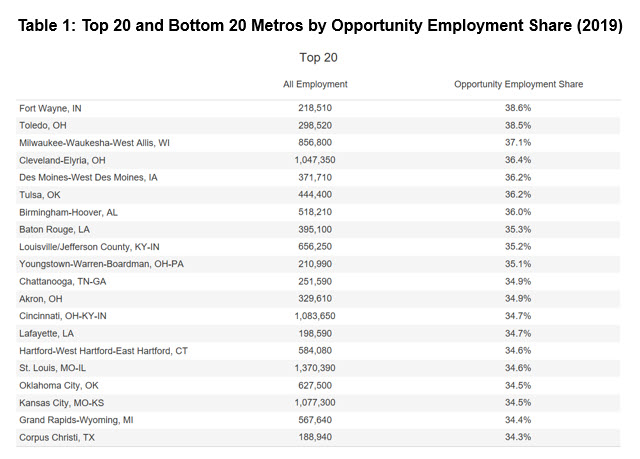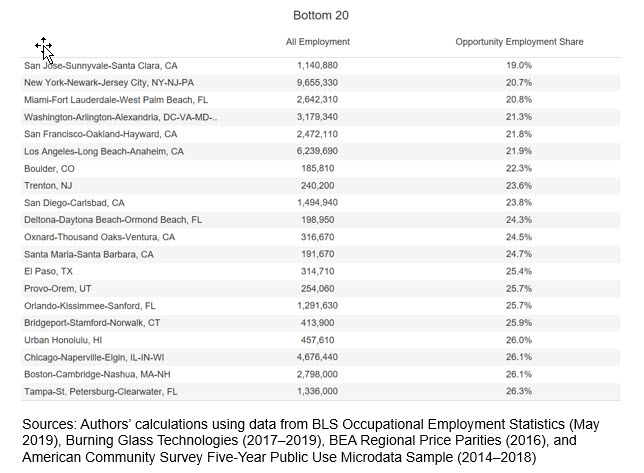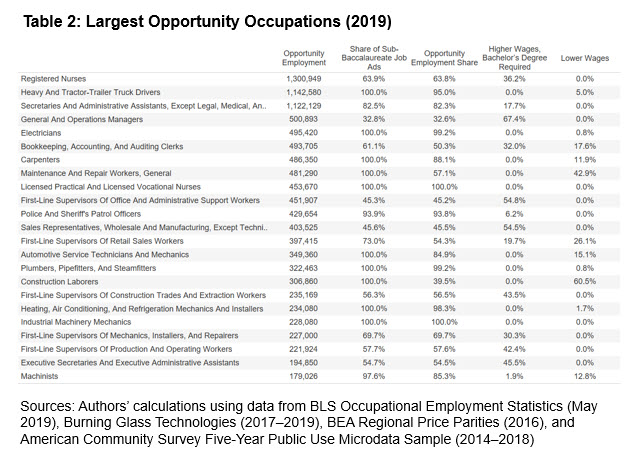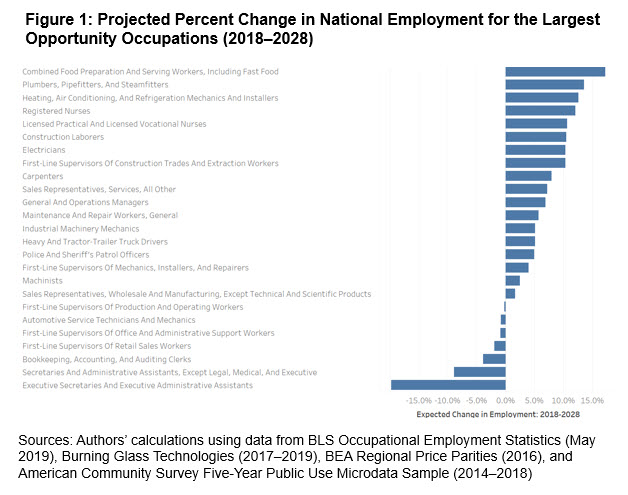
Utilizing Opportunity Occupations Data for Recovery
Pearse Haley and Stuart Andreason
December 23, 2020
2020-16
https://doi.org/10.29338/wc2020-16
Download the full text of this paper (238 KB)
The COVID-19 pandemic has created an unprecedented economic crisis, with tens of millions of American workers losing their jobs since March. The disproportionate impact of this crisis on women, communities of color, and particularly those in lower-wage occupations, highlights the need to address intergenerational racial inequity with programs and policies that connect workers to quality jobs. But understanding which jobs are available in a local labor market is often a challenge.
Local labor markets can often be quite unique. They might have different skill needs for specific jobs, and in some markets, employers need completely different skills for the same occupations for which they are hiring. Think about a computer user-support specialist, for example. One might work for a retailer largely helping people set up devices and performing basic troubleshooting, while another might work for a research organization providing sophisticated networking and information security support. Much of the labor market data that is available does not take into account the localized and different skills needs of work.
The Opportunity Occupations Monitor combines a number of data sources, including traditional labor data from the Bureau of Labor Statistics (BLS) and O*NET, with real-time labor market data from Burning Glass Technologies to provide more locally specific information on jobs that are available. We have just updated the tool with 2019 data and will update the tool again in early 2021 with data from 2020 to reflect changes due to the COVID-19 pandemic.
The Federal Reserve Bank of Atlanta's Center for Workforce and Economic Opportunity (CWEO) has followed these types of jobs since 2015. Now, the CWEO is focusing analysis of opportunity occupations on informing local workforce development strategies for recovery from the COVID-19 crisis. To that end, the CWEO has partnered with the Markle Foundation and other organizations to launch the Rework America Alliance (RAA). This initiative seeks to provide all workers with access to employment that promotes self-sufficiency and provides opportunities for growth through workforce development programs that align the skills and expertise of workers with the demands of employers.
The CWEO's work on opportunity occupations constitutes a key body of knowledge that will influence these efforts. Opportunity occupations are defined as those that typically require less than a bachelor's degree while paying more than the national median wage adjusted for local cost of living. Opportunity occupations can help counteract the inequitable effects of the pandemic by connecting low-wage workers to employment that where they can use their existing skills without having to pursue additional education.
While our latest data do not reflect the economic shifts caused by COVID-19, they offer valuable insight into occupations and skills that can elevate workers, regardless of education. This insight will be critical to connecting workers affected by COVID-19 with high-quality job opportunities, both during and after the recovery process. Coupled with what we know about job losses related to COVID-19, the opportunity occupations data can show areas where workers may face job loss and economic stresses and need support.
What the Opportunity Occupations Monitor can tell us about skill-based transitions
A 2019 report by the Philadelphia and Cleveland Federal Reserve Banks examined opportunity employment using 2017 data from the 121 largest metros and found that opportunity employment constituted roughly 22 percent of all employment in these locations. There was significant regional variation, however, ranging from approximately 15 percent to 34 percent.1 Our analysis of 2019 data shows an average of about 30 percent for the 121 largest metros, with a range of approximately 19 percent to 39 percent. Total employment also increased in the majority of these metros, which suggests that newly added jobs are meeting the criteria for opportunity employment at a higher rate than in prior years. Table 1 shows the top 20 and bottom 20 metros for opportunity employment in 2019.


While the gap between the metros with the smallest and largest opportunity employment shares increased slightly between 2017 and 2019, many of the metros in the bottom 10 saw their shares of opportunity occupations grow at a higher rate than those in the top 10 during that same time. While we cannot draw any definitive conclusions from this trend, it is possible that employers' requirements may have loosened across metros, local cost of living has decreased, or the mix of occupations has changed.
The authors of the 2019 report found that an area's occupational mix, employer educational preference, and cost of living can significantly affect its share of opportunity employment. The latest data support these findings. Many metros with lower shares of opportunity employment— such as San Jose-Sunnyvale-Santa Clara, California—have occupational mixes that demand a high level of education and have higher costs of living. As a result, jobs that are opportunity occupations in some metros fail to meet our criteria in others. The mix of types of opportunity employment likely influences whether or not workers are able to quickly transition in the current economic shock.
Understanding how levels of opportunity employment vary across regions and occupational groups is crucial to an inclusive economic recovery. Table 2 shows the largest opportunity occupations across large metros for 2019. The occupations with lower shares of sub-baccalaureate job ads warrant closer consideration, as they also have lower shares of opportunity employment. This suggests significant variation in educational requirements and wages across regions.

Figure 1 shows the Bureau of Labor Statistics' 10-year growth forecasts for the top opportunity occupations with shares of sub-baccalaureate job ads below 100 percent. The previous update showed that the projections for these occupations varied by industry. Occupations in health care and the skilled trades had high projected growth while the opposite was true for occupations in administration and other sectors vulnerable to automation. Seven of the 25 largest opportunity occupations have negative projected growth compared with just four in 2017. The additional occupations, such as automotive service technicians and mechanics and wholesale and manufacturing sales representatives, have significant risk of automation. These longer-term risks of job loss due to automation may lead to permanent rather than temporary layoffs during the pandemic.

While COVID-19 has certainly altered these projections, the general trends displayed in the tool have tremendous value as reference points for quantifying the impact of COVID-19 on economic opportunity. It is likely that industries heavily affected by shutdowns will increase automation, employers seeking to fill in-demand jobs will raise educational and skill demands, and regional disparities between wages and living expenses will widen. Future opportunity occupations research will attempt to capture this changing landscape and its impact on the distribution of opportunity employment.
Aligning workers to opportunity occupations during and after recovery
Before the pandemic, millions of workers lacked access to middle- and high-wage employment due to the skills gap created by technological advancement and automation. Vulnerable populations such as "low-wage workers, non-college graduates, rural Americans, and minorities" face the highest risk of job loss due to automation, and COVID-19 has compounded that risk.2 Many of these displaced workers have used "on-the-job learning, community college, apprenticeships, training programs, and military service" to develop skills and experience that are "transportable" across occupational groups that contain quality jobs created by new technology.3
Opportunity@Work has coined the term Skilled Through Alternate Routes, or STARs, to describe these workers. Despite representing half of the American workforce and two-thirds of all essential workers, STARs are frequently blocked from accessing higher-wage employment because of college degree requirements. STARs are also underrepresented in higher-paying occupational groups with higher long-term growth projections.4 Many employers in industries that employ large numbers of STARs—such as retail, hospitality, and food service—have accelerated automation in response to COVID-19, increasing the risk of further polarization of the labor market. 5
Connecting STARs to career paths that offer long-term self-sufficiency with low risk of automation will be crucial to both short-term economic recovery and the long-term promotion of economic mobility and resiliency for all workers. Research on opportunity occupations can help build these connections by "exploring the ways in which a region's occupational mix and its cost of living interact with employers' educational preferences to produce dramatically different levels of economic opportunity" across regional labor markers.6 Building out a framework of interventions that work in local contexts is a key goal of the Rework America Alliance.
Recent research by the Federal Reserve Banks of Cleveland and Philadelphia introduced a new methodology for identifying pathways from low-wage work to opportunity occupations.7 The study compared skills overlaps across metros using job postings data and found that nearly half of lower-wage occupations had at least one potential transition to a higher-paying occupation with similar skill requirements. Most of the transitions would result in an average wage increase of $15,000. Many of these transitions also led to different occupational groups. Transitions varied across metros, highlighting the need to understand regional differences in employer skill and education preferences to connect STARs and other displaced workers with quality employment. Employee-reported skills and activities can shed light on what skills employees use on the job that may not appear in job postings. This information can help unemployed workers make use of their full portfolio of skills to find better jobs quickly.8
Implications
The pandemic has highlighted a need for innovative workforce development efforts that include skill-based pathways to employment and reflect the disparate impact of unemployment on vulnerable groups of workers. Research on opportunity occupations can support the development of a "new system of worker training aligned to good jobs that employers need to fill". By identifying the good jobs that are accessible to workers and the specific skills necessary to make transitions to opportunity employment from low-wage work, this research can support the development of the types of new tools and training programs necessary for broader systems change.
The Opportunity Occupations Monitor, as well as many other tools in the Rework America Alliance, aim to help workers and organizations find ways to navigate the labor market, identify new opportunities, and understand where there are likely some economic stresses in sectors and communities. In the coming months, look to the RAA for tools to help these stakeholders navigate transitions in the labor market due to COVID-19 and other disruptions.
Pearse Haley is a research analyst I at the Center for Workforce and Economic Opportunity, where Stuart Andreason is the director.
_______________________________________
1 Wardrip, K., Fee, K., and Nelson, L. (2019). “Opportunity Occupations Revisited: Exploring Employment for Sub-Baccalaureate Workers Across Metro Areas and Over Time.” Special Report of the Federal Reserve Banks of Philadelphia and Cleveland.
2 Future of Work. (2020). Opportunity@Work.
3 "Shining a Light on STARs: The Essential Workers of COVID-19." (2020). Opportunity@Work.
4 Ibid.
5 WorkingNation Editorial Team. (2020, August 4). "Oates: Many employers have used this COVID time to accelerate automation." WorkingNation.
6 Wardrip, Fee, and Nelson.
7 DeMaria, K., Fee, K., and Wardrip, K. (2020). "Exploring a Skills-Based Approach to Occupational Mobility." Special Report of the Federal Reserve Banks of Philadelphia and Cleveland.
8 Andreason, S., Haley, P., Miller, S., and de Zeeuw, M. (2020, June 29). "The Digital Divide and the Pandemic: Working from Home and Broadband and Internet Access." Special Report of the Federal Reserve Bank of Atlanta.


